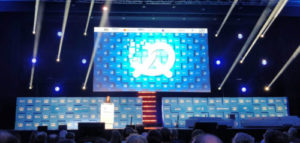The short answer? It’s a way to actively support the free web.
The long answer? That involves the demographics of ad blocking users, their commitment to journalism and publishing, and the types of ads they want to block.
We’re going to tackle all of that.
“A Very Savvy Demographic”
Tim Cronin, AAX VP of Sales, used the opportunity of speaking at Digiday Publishing Summit, Budapest to describe just who ad blocking users are.
“They’re a very savvy demographic,” he said. “They’re younger, they’re well-educated, they’re tech savvy, and they index high for consuming media.”
The numbers prove it: US-American ad blocking users, 64% of whom are under the age of forty-five, are 1.5x more likely than the average American to have a bachelor’s degree. And that number goes up to 3x when only the 18-24 year olds are considered. (Source)
These young, well-educated ad blocking users not only enjoy consuming media, but they have an understanding of the value of media. For example, they’re more likely to pay for online subscriptions to magazines and news services than their non-ad blocking counterparts. (GlobalWebIndex, 2019)
“The Value of a Free Press”
All of the factors that make the ad blocking demographic unique—age, education, and interest in participating in the value exchange of online media—coalesce around the question of publishers.
The desire for content access is matched by a growing understanding that ad revenue helps keep publishers’ lights on. Publishers have become vocal about the fact that ad revenue is what allows them to hire talent, create content, and maintain a high standard of quality.
Websites often suggest that browsers subscribe or donate in order to keep browsing. And this tactic seems to have been moderately successful: 15% of users are willing to either pay for the content they enjoy or donate money directly.
Another tactic is suggesting that users turn off their ad blockers. This is successful approximately one-third of the time: 31% would be fine with seeing ads in order to support websites. This includes writer Mark Wilson, who asserts he doesn’t install an ad blocker because he “cares about the value of a free press.”
The vast majority of users also care about the value of a free press, but they’re still concerned about the nature of ads being served. 68% agree with the statement “I’m fine with seeing ads, but only if they’re not annoying.”
As Tim Cronin puts it, “[Ad blocking users] need their favorite publishers to continue to exist. If they don’t subscribe, they’re willing to receive unobtrusive ads.”
“They Just Hate Certain Types of Ads”
When users were asked which ads they considered annoying, they overwhelmingly spoke of pop-ups and video ads. These are the ones that users “dislike”—according to the 2018 Hubspot Survey “Why People Block Ads, and What It Means For Marketers and Advertisers,” a full 73% of users disapproved of pop-ups.
When this is compared to percentage of users who disliked magazine and print ads (18%) and billboard ads (21%), it becomes apparent that it’s not the fact of the ad itself that’s annoying.
With ads, the medium is the message. A static, text-and-image ad is respectful. A glittery pop-up, however? That’s obnoxious
At Digiday Budapest, Tim Cronin summarized the relationship between ad blocking users and ads: “Ad blocking users don’t hate all ads. They just hate certain types of ads—the ones that feel intrusive.”



